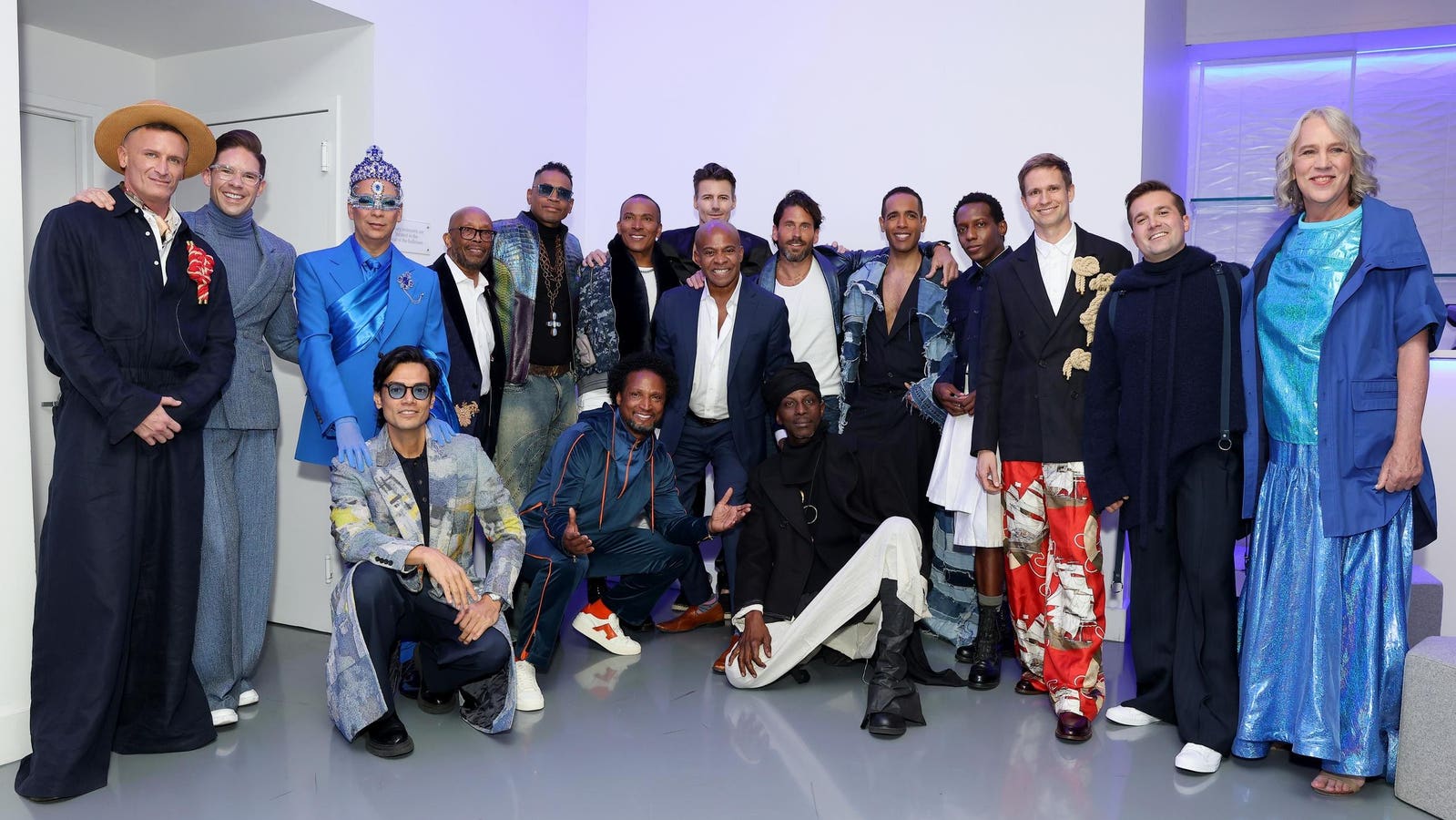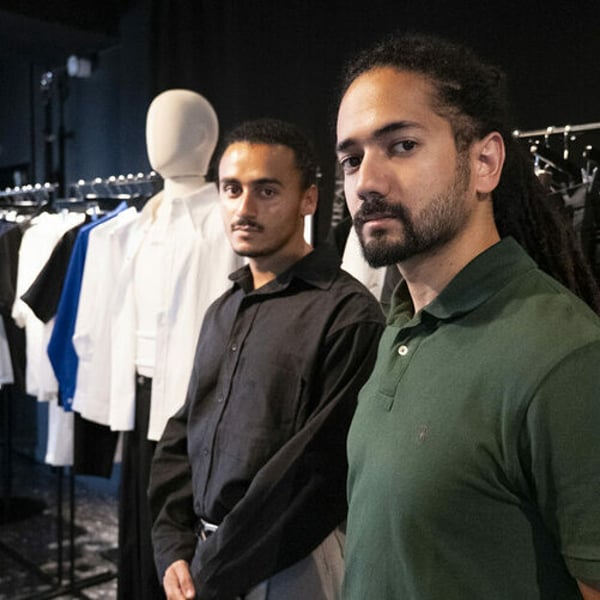NEW YORK, NEW YORK – FEBRUARY 04: (L-R) John Hill, Frank DiLella, James Aguiar, Omar Hernandez, … More
New York Fashion Week has long been a stage for reinvention, influence, and cultural moments. Yet, among all the headline-grabbing collections and high-profile front rows, one show emerged as arguably the most important of them all.
The Blue Jacket Fashion Show is unlike anything else on the calendar. While other runway shows celebrate style, spectacle, and craftsmanship, this one uses fashion as a vehicle for something bigger—prostate cancer awareness, early detection, and addressing health disparities in underserved communities. The event, now in its ninth year, founded by fashion designer Frederick Anderson and sponsored by global healthcare brand Johnson & Johnson, under the leadership of President of the Solid Tumor Business, Oncology Biljana Naumovic, brings together a diverse mix of cultural figures—scientists, actors, models, media personalities, and athletes—many wearing blue jackets—to spotlight racial disparities in prostate cancer outcomes and the urgent need for screenings.
NEW YORK, NEW YORK – FEBRUARY 04: Biljana Naumovic, President, U.S. Solid Tumor, Johnson & Johnson, … More
This year’s annual show didn’t just kick off New York Fashion Week—it did so on World Cancer Day, reinforcing its life-saving mission. The star power—from Bill Nye in a Thom Browne bomber jacket, to Don Lemon and Mario Cantone—made the runway feel more like a movement than a fashion moment.
Prostate cancer is a common cancer and the second-leading cause of cancer death among men in the U.S. It’s especially deadly when prostate cancer cells spread beyond the gland, turning into advanced prostate cancer or even metastatic prostate cancer. The major known risk factors for prostate cancer include age, ethnicity, obesity, and family history. The risk of prostate cancer is significantly higher for Black men, who face a 70% greater risk and more than double the mortality rate compared to white men. These disparities are often magnified in underserved communities—particularly those with limited access to preventive care and screenings. Regions such as parts of South Florida, San Antonio, Kansas City, and Washington, D.C. face notable challenges, where routine prostate biopsies, early-stage prostate cancer detection, and access to treatment for prostate cancer can be under-resourced—especially in neighborhoods with high uninsured or minority populations.
At a time when purpose has become the ultimate differentiator for brands—especially among Generation Z—I believe the Blue Jacket Fashion Show proves that the most memorable moments in fashion aren’t just seen; they’re deeply felt, eagerly shared, and acted upon.
So what makes this event so powerful?
The Power of Authenticity and Purpose in the Blue Jacket Fashion Show
At New York Fashion Week, the Blue Jacket Fashion Show has created a must-attend show that makes room for meaningful conversations, professional connections, and cultural conversations about a critical issue. The show doesn’t just use fashion to entertain and inspire—it turns it into a platform for educational business services and realms of fashion that go beyond the runway.
NEW YORK, NEW YORK – FEBRUARY 04: Alex Lundqvist walks the runway wearing Stephen F during the 9th … More
Instead of treating prostate cancer awareness as a purposeful afterthought, the show makes it the zeitgeist of innovation—a central cause integrated into casting, partnerships, and storytelling.
Participants included house music legend Crystal Waters in anticipation of her new comeback single You and Me, leaders in fashion such as Stephen F—the menswear label founded by Swedish designer Stephen Ferber, known for its bold tailoring and refined aesthetic—and Ty Hunter, the celebrity stylist best known for shaping Beyoncé’s iconic looks and redefining red carpet style through his innovative, inclusive approach. They’re joined by actors, chefs like Marcus Samuelsson, photographers like Nigel Barker, and advocates such as Dominic Fumusa.
NEW YORK, NEW YORK – FEBRUARY 04: Ty Hunter walks the runway wearing Tommy Hilfiger during the 9th … More
I found myself being educated by passionate attendees of the show on terms often unfamiliar inside any fashion week and outside of most clinical settings—like low-grade prostate cancer, castration-resistant prostate cancer, watchful waiting, and radical prostatectomy—transforming them from jargon into accessible talking points.
According to research by NielsenIQ, purpose-driven brands consistently outperform their peers, with 57% of consumers expressing greater loyalty to brands that actively address social inequities. In an age of heightened social awareness, audiences are not only noticing which brands take a stand—they’re rewarding them with long-term commitment and advocacy. Further reinforcing this, an Ipsos study, highlighted by the World Economic Forum, revealed that consumer brand preferences are increasingly shaped by alignment between a brand’s values and their own. This correlation has only grown stronger over the past eight years, signaling a seismic shift in how people choose the brands they buy, support, and promote.
Crystal Waters at the 9th Annual Blue Jacket Fashion Show held at Lavan Midtown on February 4, 2025 … More
Together, these findings point to a simple but powerful truth: purpose isn’t a nice-to-have—it’s a strategic imperative. Brands that lead with authenticity and values are no longer the outliers—they’re the outperformers.
Influence Isn’t About Perfection—It’s About Passion and Real Connection
The show featured a mainly all-male model lineup, ranging from runway models to scientists, entertainers, and people with personal connections to prostate cancer treatment and prostate cancer diagnosis. Figures like Bill Nye weren’t there for fashion clout—they were there to move the needle on a common disease affecting millions.
That’s what, I believe, made the influence so authentic: the people on stage weren’t actors in a campaign—they’re believers in the cause. Some have faced enlarged prostates, others have supported loved ones through radiation therapy or prostate biopsies. The inclusion of such voices highlights not just the science but the emotional toll and real-world stakes.
NEW YORK, NEW YORK – FEBRUARY 04: Nigel Barker walks the runway wearing Arjona Collection during the … More
Audiences are increasingly drawn to smaller creators, non-traditional voices, and American designers who lead with vulnerability and purpose. As I emphasize in my book, The Kim Kardashian Principle, this kind of authenticity drives deeper connection than polished perfection ever could.
For marketers and brand leaders, the takeaway from the Blue Jacket Fashion Show is simple: you don’t always need the biggest names—you need the people who are your biggest believers. When your cast of storytellers is chosen not just for reach but for relevance to the mission, the result is a campaign that feels honest, emotional, and real. And that’s what today’s audiences respond to.
A study published in the Journal of Retailing and Consumer Services revealed that 69% of respondents are more likely to trust a recommendation from a friend, family member, or influencer over messaging directly from a brand. What drives that trust? Genuine connection—a sense that the person promoting the message actually cares.
NEW YORK, NEW YORK – FEBRUARY 04: (L-R) Frank Acosta, Mike Woods and Louis Finley pose backstage … More
That insight is echoed in a study from Roger Williams University, which found that audiences are significantly more likely to make a purchase when they perceive influencers as authentic and sincere in their brand partnerships. That’s why the Blue Jacket Fashion Show’s eclectic mix of participants works well: they’re not walking the runway for clout—they’re there because the cause matters to them.
As Vogue Business reports, smaller creators and non-traditional voices—those who produce more raw, real, and relatable content—are now driving the most meaningful trends. This shift reflects a broader truth for marketers: when you lead with purpose and choose voices who genuinely care, your message doesn’t just land—it lasts.
Take Something Serious—And Make It Culturally Irresistible
The Blue Jacket Fashion Show addresses one of the most serious issues in men’s health—prostate cancer—but it does so in a way that’s unexpected, dynamic, and genuinely entertaining. Rather than leaning on fear-based messaging or medical jargon, the show uses the power of humor—the power of which I have spoken about before—to engage audiences and infuses the cause with style, wit, and cultural relevance.
From runway appearances in custom bomber jackets to viral moments on social media, the show transforms clinical trials, abnormal cells, and prostate cancer symptoms into accessible, human stories.
NEW YORK, NEW YORK – FEBRUARY 04: Bill Nye walks the runway at the 9th Annual Blue Jacket Runway … More
The runway lineup of eclectic, purpose-driven personalities transformed the event into something people actually want to engage with and talk about. The message doesn’t get lost—it lands harder, because it’s delivered in a way that feels fresh, human, and memorable.
This approach isn’t unique to fashion. Brands across industries have learned to reframe heavy-duty topics through creative storytelling that feels current and emotionally intelligent. Dove’s Real Beauty campaign took on beauty standards through raw, relatable stories.
The throughline? Important doesn’t have to mean serious. When a brand is brave enough to inject style, substance, and unexpected humor into a tough subject, it doesn’t dilute the message—it makes it resonate more deeply. For marketers, the takeaway is clear: don’t make your cause harder to talk about than it already is—make it more accessible.
Research published in The Lancet confirms that mass media campaigns—when done right—can lead to measurable shifts in public health behavior across entire populations. It’s not just about getting attention; it’s about changing outcomes. Another Lancet study highlights the power of storytelling in health communication, citing examples like films used in East African villages to change cultural perceptions around female genital cutting.
NEW YORK, NEW YORK – FEBRUARY 04: Mario Cantone walks the runway wearing Gustavo Moscoso during the … More
Closer to home, the Truth anti-tobacco campaign in the U.S. showed how bold, entertaining, and youth-focused content could shift perceptions about smoking. The campaign’s edgy tone and creative storytelling weren’t just memorable—they were effective, significantly lowering youth smoking rates nationwide.
These examples reinforce what the Blue Jacket Fashion Show understands intuitively: when you make the message engaging, it travels further, sticks longer, and drives real behavior change.
Great Leaders Use Storytelling to Drive Impact
At the heart of the Blue Jacket Fashion Show is a masterclass in how visionary leadership uses storytelling to drive cultural and behavioral change. Frederick Anderson, the designer and force behind the event, doesn’t just produce a fashion show—he constructs a narrative. One where the iconic blue jacket, often a boy’s first step into formal adulthood, becomes a symbolic call to action for men to take charge of their health.
NEW YORK, NEW YORK – FEBRUARY 04: Frederick Anderson, founder of the Blue Jacket Fashion Show, … More
In Frederick Anderson’s hands, fashion transcends aesthetics; it becomes a medium for meaning, and the runway a stage for urgency. Complementing this creative force is the corporate leadership of Johnson & Johnson, whose deep commitment to health equity powers the initiative beyond symbolism. Through campaigns like Talk That Talk™ and BRCA in Men/Dad Genes, they ground the storytelling in tangible action—amplifying awareness, normalizing conversations, and driving screenings in communities that need it most.
This seamless fusion of emotive storytelling and operational impact is what gives the show its lasting resonance. The takeaway is clear: great leaders don’t just communicate—they craft stories that move people, mobilize communities, and ultimately, change lives.
I’ve emphasized the importance of storytelling before, and research consistently underscores the effectiveness of symbolic branding in leadership and public health, too. According to the Harvard Business Review, compelling storytelling is essential for building credibility and inspiring action—key traits of impactful leadership. The FBI’s Law Enforcement Bulletin adds that stories enable leaders to communicate vision and mission in a way that is both memorable and emotionally resonant. In the context of health communication, a study in the International Journal of Environmental Research and Public Health found that health branding significantly influences behavioral choices by fostering emotional identification with the message.
Together, these findings validate the strategy behind the Blue Jacket Fashion Show: by combining symbolic fashion with meaningful narrative, it creates a powerful platform that drives awareness, engagement, and action.
Measuring Impact: Beyond Impressions
As the presenting sponsor of the Blue Jacket Fashion Show, Johnson & Johnson takes a multi-dimensional approach to measuring success—one that moves well beyond traditional metrics like impressions or brand exposure. For J&J, the runway is just the beginning. Their strategy is centered on empowering communities, sparking essential conversations, and ultimately increasing prostate cancer screenings—especially among populations at higher risk.
IRVINE, CALIFORNIA – OCTOBER 17: The Johnson & Johnson logo is displayed at company offices on … More
To assess the reach and resonance of the show, J&J employs a digital-first strategy rooted in real-time data. Organic and paid content flows through J&J Innovative Medicine’s social channels, supported by collaborations with event participants, health advocates, and influencers who bring authentic, trusted voices into the conversation.
Through partnerships with the Blue Jacket Fashion Show’s platforms and the use of co-branded content, the campaign extends its reach, inviting meaningful public engagement. Metrics like hashtag performance, share rates, sentiment analysis, and engagement trends help J&J gauge not just visibility—but emotional and behavioral impact.
And the most important metric? The real-world health outcomes: prostate cancer diagnoses caught early, the risk for prostate cancer lowered through education, and more men opting for early-stage detection rather than late-stage, high-risk treatment for prostate cancer.
NEW YORK, NEW YORK – FEBRUARY 04: Alex Lundqvist poses backstage during the 9th Annual Blue Jacket … More
According to Johnson and Johnson, on the day of the show, 72 men received free prostate cancer screenings at dedicated events in Harlem and Brooklyn—organized in partnership with ZERO, LISC, Carver Bank, and a local healthcare provider who also walked in the fashion show. These on-the-ground efforts illustrate how a fashion moment can catalyze life-saving action.
The Future of Fashion Is Purpose-Driven
At its core, the Blue Jacket Fashion Show is about changing the conversation—both in fashion and in men’s health. Frederick Anderson wants people to feel free to talk—openly and without stigma—about their prostate health and about prostate cancer. And as Biljana Naumovic of Johnson & Johnson put it: “We want every single man to get tested, and we want the best therapies delivered early—so prostate cancer can be cured.”
NEW YORK, NEW YORK – FEBRUARY 04: J. Harrison Gheewalks the runway at the 9th Annual Blue Jacket … More
This directness is part of what gives the show its power. By blending honest dialogue with bold design and public visibility, the event creates a space where awareness leads to action—and where health conversations become as natural as style ones.
In doing so, the Blue Jacket Fashion Show stands apart—not just as a runway event, but as a blueprint for how the worlds of fashion, health, and social responsibility can intersect with power and purpose. I see it as proof that cultural capital can be leveraged not only to shape tastes, but to save lives.
What Frederick Anderson and Biljana Naumovic have built is more than a marketing campaign—it’s a case study in modern influence. One that shows how authentic storytelling, emotionally intelligent branding, and diverse, mission-aligned voices can come together to move beyond awareness and into action. From prostate cancer screenings in underserved communities to viral conversations that break stigma and spark behavior change, the show’s success isn’t measured in applause—it’s measured in impact.
I believe the takeaway is clear: if you want to create work that resonates, it has to be rooted in something real. Not just relevance, but responsibility. Because in a world where everyone’s chasing visibility, the real question is: We all want attention—but what’s your intention?
Named Esquire’s Influencer of the Year, Jeetendr Sehdev is a media personality and leading voice in fashion, entertainment, and influence, and author of the New York Times bestselling phenomenon The Kim Kardashian Principle: Why Shameless Sells (and How to Do It Right).


